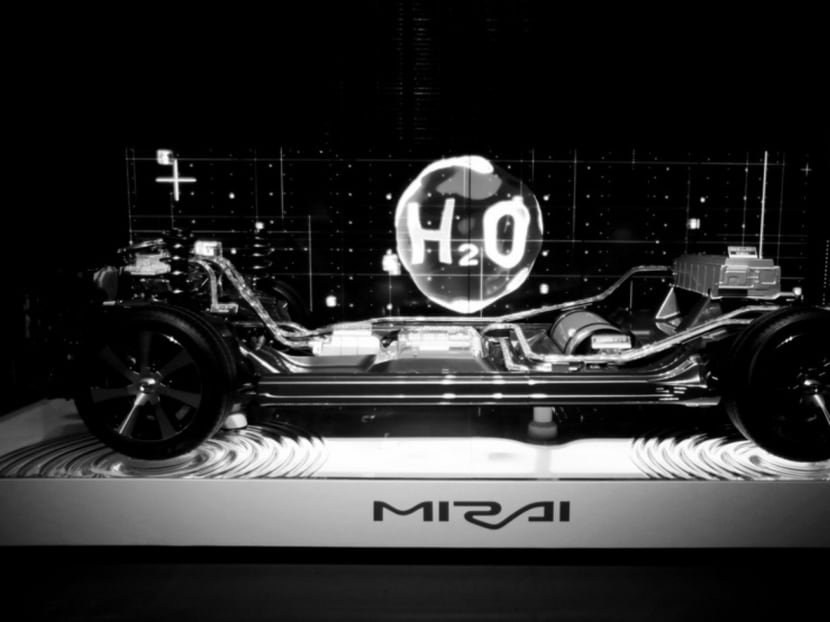Will Toyota’s new hydrogen car be the next Prius?
On Dec 15, Toyota released the Mirai, a hydrogen car, in Japan. Other car firms such as Honda, Audi, Hyundai, General Motors and Mercedes-Benz are also planning to release their own versions. Hydrogen cars can either burn the gas in an engine or use it in fuel cells to drive an electric motor, producing water as a by-product.

The bare chassis of Toyota’s new hydrogen sedan car Mirai, which means ‘future’ in Japanese, during an unveiling event last month. Photo: Reuters
On Dec 15, Toyota released the Mirai, a hydrogen car, in Japan. Other car firms such as Honda, Audi, Hyundai, General Motors and Mercedes-Benz are also planning to release their own versions. Hydrogen cars can either burn the gas in an engine or use it in fuel cells to drive an electric motor, producing water as a by-product.
Hydrogen is one of the most abundant elements on earth and is one of the building elements of the water molecule. In its gaseous form, it was famously used during the early part of the 20th century for the transatlantic Zeppelins that used to ferry passengers until the Hindenburg burst into flames in 1937 in Lakehurst, New Jersey.
But modern standards of handling hydrogen have improved greatly in terms of safety and efficiency. Several articles said Toyota even went to the extent of testing its hydrogen fuel tank to withstand gunshot bullets and extreme crash tests. The Mirai fuel tank uses triple-layered carbon fibre, one of the strongest materials available.
Several experts have said hydrogen has got a bum rap from the Hindenburg disaster, but is actually safer than petrol, even if it leaks.
Hydrogen is often made from methane or from thermally gasifying, in a low-oxygen environment, fossil fuels such as coal, which releases the hydrogen in gaseous form, but does not release the carbon into the atmosphere. It can also be made from waste-to-energy processes. There are also other methods, including electrolysis, but these are expensive.
Because the by-product of a fuel cell is water and not greenhouse gases, hydrogen is a very environmentally-friendly gas. In fact, the United States National Aeronautics and Space Administration has been using hydrogen fuel cells to produce electricity and water for its space missions. But special materials that can withstand hydrogen’s very reactive properties have to be used.
Critics abound such as Mr Elon Musk, chief executive officer of Tesla, whose latest version of its electric car can now go over 640km on a charge, and Dr Joseph Romm, a former US Department of Energy official, who argue that the environmentally-friendly nature of using hydrogen at the vehicle-end should factor in the energy required to produce it.
CHALLENGES TO GO HYDROGEN
Make no mistake. Toyota’s effort at a hydrogen car will be fraught with challenges both technological and economic. These include the high cost of the vehicles, the challenges of producing hydrogen at low cost and the lack of a fuelling infrastructure. Although there are still technological hurdles, a lot of it is now shifting to the economic side. The fuel cell itself is still expensive, especially due to the use of platinum as a catalyst, although research continues to try to find ways to drop its price. Media reports estimate the Mirai to retail in Japan initially for US$58,000 (S$76,700).
Take for example a potential Singaporean buyer of a hydrogen car. To be practical, Singapore has to be dotted with a few hydrogen-charging stations, allowing the user to operate the vehicle for a few days, including possibly crossing over to Malaysia for a trip, although the range on a full tank of hydrogen can go up to 480km. Such considerations need to be factored in. Early buyers would most probably be environmentally-conscious early adopters, who want to make a statement and who do not mind paying the high price tag to be different from their peers.
Unfortunately, unlike the turn of the 20th century, which saw the development of early vehicles such as the Ford Model T going hand in hand with the development of the petroleum industry, there are now other alternatives. So hydrogen vehicles have to contend with fragmented efforts, unlike when the petrol/diesel car was developed; it was mostly for all intents and purposes the only game in town. Now there are other technologies out there such as the electric car.
The hydrogen car does have one advantage. It can be filled up in a few minutes quickly and can run up to 480km on a tankful. Contrast this with the 20 minutes it takes for a Tesla to charge its battery halfway and that is already state-of-the-art for electric vehicle fast-charging.
In building a hydrogen car and releasing it to the market, Toyota has thrown its multi-billion-dollar muscle into a new market as it had done with the Prius hybrid, which has been a success for the company.
Whether to go hydrogen or not is an issue that will occupy the automotive community for some time with endless debate and discussion. Whether the ecosystem responds will remain to be seen, but at least we can say that Toyota has made the first move.
ABOUT THE AUTHOR:
Dennis Posadas is the author of Greenergized and is working on a new business fable on corporate sustainability.






